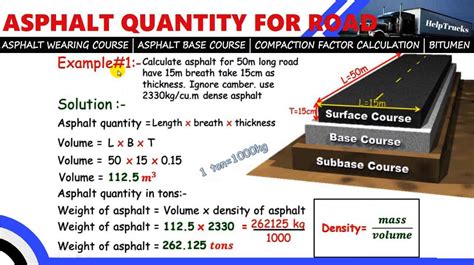Asphalt Ton Calculation: Advanced Techniques
Calculating the tonnage of asphalt needed for a paving project is crucial for accurate budgeting, efficient material ordering, and project success. While basic calculations exist, advanced techniques are necessary for complex projects involving varied pavement depths, intricate shapes, and multiple layers. This article delves into these sophisticated methods, providing you with the tools to accurately determine your asphalt requirements.
Understanding the Fundamentals: Basic Asphalt Calculations
Before exploring advanced techniques, let's review the foundational principles. The basic formula for asphalt tonnage calculation is:
Area (sq ft) x Thickness (in) x Density (lbs/cu ft) / 2000 (lbs/ton) = Tons of Asphalt
This formula relies on accurately measuring the project area and desired pavement thickness. The density of asphalt varies depending on the mix design, typically ranging from 140 to 150 lbs/cu ft. However, this simple calculation falls short when dealing with nuanced project parameters.
H2: Accounting for Compaction: A Crucial Factor
One significant oversight in basic calculations is the impact of compaction. Asphalt is compacted during the paving process, reducing its volume. The degree of compaction is expressed as a compaction factor, typically ranging from 0.90 to 0.95. This means that for every cubic yard of asphalt placed, only 0.90 to 0.95 cubic yards remain after compaction.
To incorporate the compaction factor, the formula is adjusted:
Area (sq ft) x Thickness (in) x Density (lbs/cu ft) / (2000 lbs/ton x Compaction Factor) = Tons of Asphalt
Using a compaction factor significantly improves the accuracy of your asphalt tonnage estimate.
H2: Dealing with Variable Pavement Thickness
Many projects involve variations in pavement thickness, such as thicker areas at intersections or curves. Simple calculations fail to capture these subtleties. Advanced techniques involve breaking down the project into smaller areas with consistent thicknesses, calculating the tonnage for each area, and summing the results. This can be achieved using CAD software or surveying techniques to create a detailed area map with thickness variations.
H2: Calculating Asphalt for Complex Shapes and Curvatures
Curved roadways and irregularly shaped areas pose further challenges. Basic formulas are inadequate here. Advanced techniques involve using geometric formulas to calculate the area of each section or employing digital tools like CAD software or specialized paving software that can accurately measure areas of irregular shapes and incorporate variable thicknesses.
H2: The Role of Multiple Asphalt Layers
Multi-layered pavements (base course, binder course, surface course) require a calculation for each layer. The thickness, density, and compaction factor may differ for each layer. Calculate the tonnage for each layer separately using the adjusted formula, then sum the results to obtain the total asphalt tonnage required.
H2: How to Incorporate Waste and Overages
Always account for waste and overages. Inefficiencies during the paving process, material spillage, and the need for extra material to address unexpected issues should be factored into your calculations. A 5-10% overage is generally recommended, but this can vary based on project complexity and experience.
H2: Utilizing Advanced Software for Asphalt Tonnage Calculation
Modern paving software significantly simplifies the process. These programs allow for importing survey data, creating detailed pavement designs, and automatically calculating asphalt tonnage, considering all factors – including variable thicknesses, complex shapes, multiple layers, and compaction. The results are far more precise than manual calculation methods.
Conclusion: Mastering Asphalt Tonnage Calculation for Successful Projects
Accurate asphalt tonnage calculation is paramount for any paving project. While basic calculations provide a starting point, understanding and applying advanced techniques ensures efficiency, minimizes waste, and contributes to project success. By considering compaction, variable thickness, complex shapes, multiple layers, waste factors, and leveraging advanced software, you can confidently determine your asphalt needs and make informed decisions throughout the process. Remember, precision in this phase translates directly to cost savings and project efficiency.

